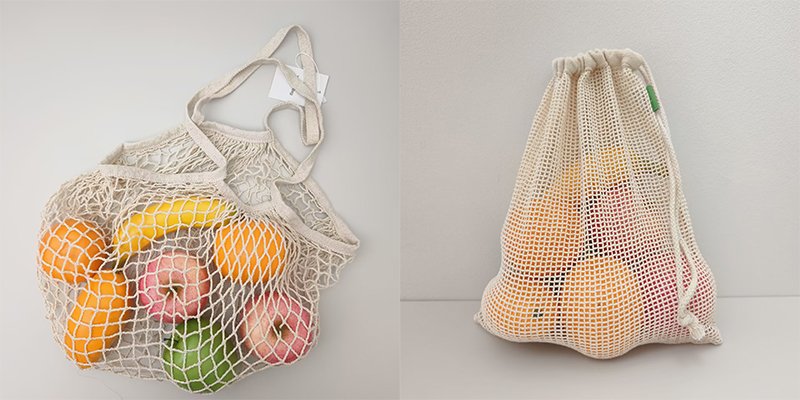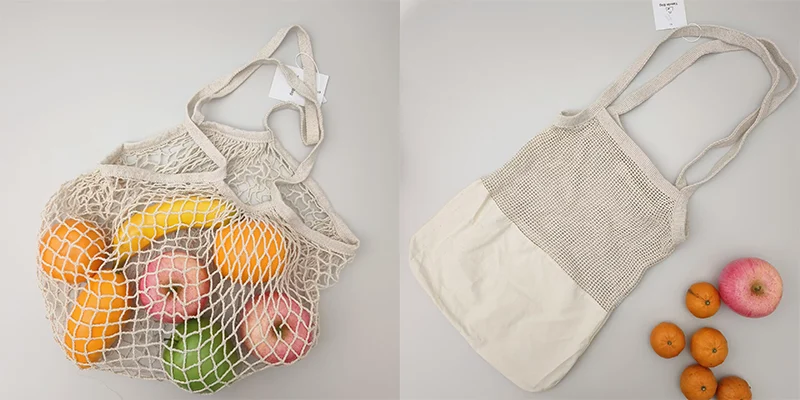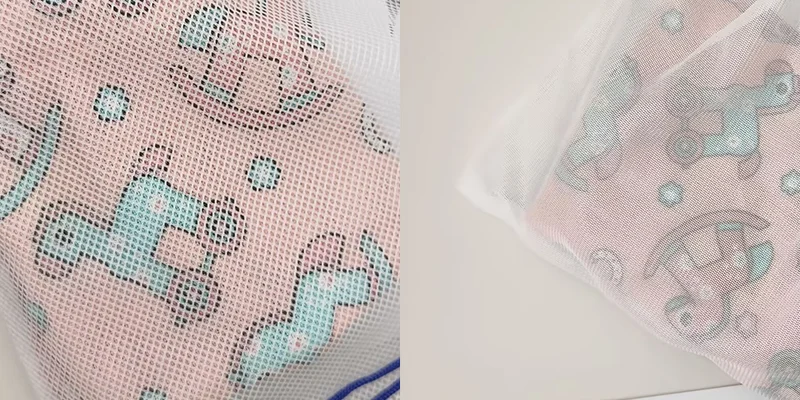
When choosing a mesh bag, it’s important to understand the differences between fabrics. Labels like “eco-friendly cotton” or “durable nylon” can be helpful, but they don’t fully explain the real features of each material. Mesh fabrics vary a lot in terms of strength, breathability, durability, and sustainability. In the following sections, we’ll take a closer look at some of the most common options, so you can see how they’re used in practice and choose the fabric that best fits your needs—whether that’s functionality, budget, or sustainability.
Cotton mesh comes in both organic and regular cotton options. True
Cotton mesh is available in organic cotton with eco certifications, as well as regular cotton that is more affordable and flexible in MOQ.
Regular cotton requires a higher minimum order quantity (MOQ) than organic cotton. False
Organic cotton usually has a higher MOQ, while regular cotton is more flexible and cost-effective.
The size of the mesh in cotton fabric not only affects breathability but also shapes the design style and application of the bag.

Organic Cotton: Organic cotton comes with eco certifications such as GOTS, ensuring that no chemical pesticides or fertilizers are used during cultivation. This makes it a sustainable option. However, the minimum order quantity (MOQ) is usually higher, so it’s best suited for larger orders. For brands that care about sustainability and image, organic cotton is an ideal choice.
Regular Cotton: Compared with organic cotton, regular cotton is more affordable and requires a lower MOQ, making it the first choice for most customers. It still offers good breathability and comfort, making it suitable for everyday use. Since its production process is more conventional, it’s a practical option for customers with tighter budgets or those who need more flexible purchasing quantities.
Polyester mesh is the most commonly used mesh fabric. It is lightweight, moisture-resistant, and durable. Some of the most common types include:
Hexagonal Mesh: With relatively larger openings, hexagonal mesh provides excellent breathability, making it ideal for drawstring bags and laundry bags. Its lightweight and breathable nature makes it versatile for many uses, which is why it is the most widely applied option.
Diamond Mesh: Similar in appearance to hexagonal mesh but with a slightly higher cost. It is also used in drawstring bags and, in some cases, product packaging, where brands want to create a different visual effect.
Twist Mesh: A variation of polyester mesh with a softer feel and stronger flexibility, making it especially suitable for laundry bags. Its durability allows it to withstand repeated pulling and friction, which is why it is widely used in household products.
Thicker Mesh: For tote bags or beach bags, many customers prefer thicker mesh fabrics. Compared to lighter mesh, this material gives the bag more structure and can carry larger capacities, making the bag appear sturdier. Common choices include heavy polyester mesh or, for an upgrade, nylon mesh.

Nylon mesh is known for its high strength, flexibility, and abrasion resistance, making it more durable than polyester mesh. It is commonly used in tote bags, beach bags, and sports bags that need to withstand frequent use. It can also be applied to storage products where extra durability is required.
However, nylon mesh is less commonly used in production and sourcing because it typically costs more than polyester. For customers who prioritize longevity and wear resistance, nylon mesh is a great choice. But for most everyday needs, polyester mesh remains the more common option.
Nylon mesh is stronger and more abrasion-resistant than polyester mesh. True
Nylon mesh is known for its higher strength, flexibility, and wear resistance compared with polyester mesh.
Twist mesh is mainly used for tote bags and beach bags. False
Twist mesh is softer and flexible, making it ideal for laundry bags, not tote or beach bags.
Shoulder Bag → The most common choice is large mesh cotton, which provides strong breathability and a natural, eco-friendly look. Some customers also prefer designs that combine small mesh cotton with solid cotton fabric, placing the mesh at the top and cotton at the bottom for better privacy and a more stylish appearance.
Drawstring Bag → Options include small mesh cotton (used alone or combined with cotton fabric), polyester mesh (hexagonal or diamond mesh), or nylon mesh for greater durability.
Tote Bag / Beach Bag → These are usually made with thicker polyester mesh or nylon mesh. Compared with lightweight mesh, these materials create a sturdier shape, larger capacity, and stronger durability, making them ideal for the beach, travel, shopping, or carrying bulkier items.
Laundry & Storage → Commonly use polyester mesh such as hexagonal mesh or twist mesh, which are lightweight and resistant to friction.
Eco & Branding → For eco-focused projects, organic cotton mesh is the best choice. For everyday projects, regular cotton or polyester mesh is more cost-effective.
If you’re looking for mesh bags or produce bags for supermarkets, household storage, or brand promotion, Yanxin Bag, as a professional mesh bag manufacturer, can provide you with a wide range of custom mesh produce bag solutions. We have years of experience producing hexagonal mesh, diamond mesh, nylon mesh, and other structures, widely used in drawstring bags, laundry bags, shoulder bags, and eco-friendly projects.
Get in touch with Yanxin Bag, and with our established production process and flexible MOQ, we’ll be your trusted mesh produce bag factory partner.
Looking for a full understanding of reusable produce bags?
This article begins by defining reusable produce bags and reviewing their background. It thoroughly explores their usage advantages, introduces a wide variety of structural styles, and ends with a complete customization guide that includes materials, printing, sizing, and care advice.
Curious about how mesh bags are used for laundry?
This article introduces laundry mesh bags and explains their protective function during washing. It details their advantages for clothes care, outlines common applications, and discusses how different closure types affect daily use.
Want to extend the life of your cotton mesh bags?
This article focuses on care techniques for cotton mesh produce bags. It explains when and how to wash them, compares hand and machine washing, offers drying suggestions, and provides storage tips to avoid damage or contamination.
Thinking about switching to mesh produce bags?
This article introduces what mesh produce bags are and highlights their functional benefits. It walks through practical pros and potential cons to consider, providing a balanced view to help with informed decisions.
Not sure how mesh bags compare with plastic ones?
This article outlines the core traits of mesh produce bags and contrasts them with plastic alternatives across categories like breathability, durability, and reusability. It concludes with a concise comparison to guide practical decisions.

Get a free quote and expert consultation today. Let's bring your brand vision to life.
Answer: The most common mesh fabrics are cotton mesh, polyester mesh, and nylon mesh, each offering distinct levels of breathability, durability, appearance, and sustainability.
Answer: Organic cotton mesh is certified (e.g., GOTS), making it a sustainable option, though it typically requires higher minimum order quantities (MOQs). Regular cotton mesh is more cost-effective and flexible for smaller orders.
Answer: Mesh produce bags promote airflow around fruits and vegetables, helping to reduce moisture buildup, slow spoilage, and extend freshness compared to plastic bags
Answer: Hexagonal mesh features larger openings, providing excellent breathability and lightweight structure, making it ideal for drawstring bags and laundry bags
Answer: Knitted mesh provides flexibility and elasticity—ideal for stretchable, comfortable garments—whereas woven mesh offers more structure and durability, suitable for durable or industrial uses
Answer: Mesh grocery bags are reusable, help reduce plastic waste, are durable for heavy items, and promote ventilation to keep produce fresher, making them a sustainable choice for everyday shopping
Answer: Mesh bag fabric features an open-weave structure that delivers superior airflow, reducing moisture buildup, mold risk, and ensuring items like produce, laundry, and sports gear stay dry and fresh
Answer: Mesh produce bags—made from materials like organic cotton, nylon, or polyester—are breathable, reusable, and eco-friendly, helping maintain produce freshness and reduce single-use plastic waste
Answer: Vegetable net bags are more durable and often larger than standard mesh bags, making them ideal for bulkier items like potatoes, onions, and sweet potatoes while maintaining airflow to extend freshness

Order or no-order we are Always here to help you!
We will contact you within 1 working day, please pay attention to the email with the suffix “@yanxinbag.com”.
Order or no-order we are Always here to help you!
We will contact you within 1 working day, please pay attention to the email with the suffix “@yanxinbag.com”.